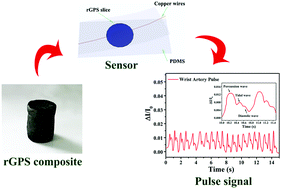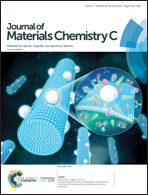Improvement of piezoresistive sensing behavior of graphene sponge by polyaniline nanoarrays†
Abstract
Following the fast development of microelectronic systems, multifunctional microelectronic components featuring high sensitivity, large stretchability, and a wide sensing range have attracted a huge surge of interest. Here, pressure sensors based on a novel three-dimensional (3D) network structure are introduced, which consist of a 3D ordered reduced graphene oxide (rGO) sponge microstructure and polyaniline (PANI) nanoarrays via interfacial polymerization and hydrothermal self-assembly processes. The nano-scaled PANI arrays greatly enhance the strength and electrical conductivity of the 3D microarchitectural rGO sponge, endowing the pressure sensor with 0.77 kPa−1 of a high sensitivity within 6 kPa, a wide reliable sensing range up to 10.22 kPa, a rapid response time of 50 ms, and an excellent stability of 3000 cycles. Accordingly, a flexible pressure sensor is fabricated based on the as-prepared sponge, which can be used as a wearable device for real-time and high-accuracy detection of subtle physiological and external stimuli, as well as large motions from the facial expression of the eye, the knee, and the finger. The outstanding piezoresistive sensing performance of this pressure sensor makes it a promising candidate for developing advanced microelectronic systems.



 Please wait while we load your content...
Please wait while we load your content...